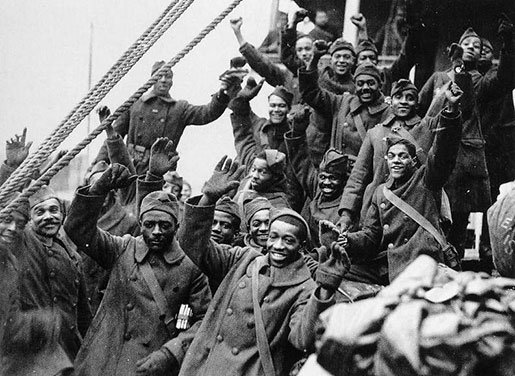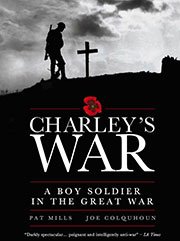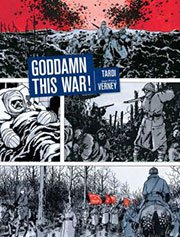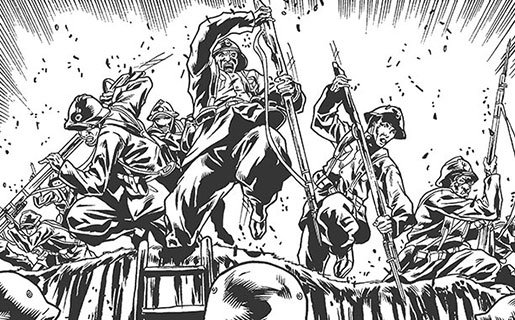It was called the “war to end all wars.” Yet this month—marking the 100th anniversary of the first battles of World War I (1914 to 1918)—brings new headlines and sound bites about wars and battles. Images of wounded children, weary soldiers, and dead bodies haunt newscasts—on TV, computer screen, and smart phone. Our phones may have grown smarter, but it seems that we have not. We still wage war. In this centennial of what was once also called the “Great War,” an upsurge in graphic literature about World War I reminds us just how little is great about any war. Instances of heroism, acts of loyalty and compassion—all are eclipsed finally by the horrors of warfare. Some new graphic works about World War I point this out, as does the reissue in book format of a classic weekly comics series about that conflict. Still, the creators of one new graphic work were inspired by the overlooked heroism and patriotism of African American soldiers. This reclaimed history of the United States’ shorter, later involvement in World War I (1917 to 1918) is the focus of Max Brooks and Canaan White’s The Harlem Hellfighters (2014), which I will discuss closer to the end of my post. First, I look at books concentrating on the entirety of World War I or its earlier years.
“Charley’s War,” written by Pat Mills and illustrated by Joe Colquhoun, first appeared as a weekly series in the British comic book Battle. The likeability and vividly terrible experiences of its central character, 16 year-old Charley Bourne, soon made this series the most popular part of Battle. Between its first appearance in 1977 and its conclusion in 1986, each 3 to 4 page long episode of “Charley’s War” was eagerly awaited by readers young and old. The talented team of Mills and Colquhoun (that’s pronounced “Col-hoon”) made it painfully easy to identify with naïve, patriotic Charley, a British working-class kid who lies about his age to enlist in the middle of World War I. Unlike the typical comic book soldier, Charley was shown with his family in daily life, and letters and post cards from and to his London family became a movingly ironic part of the series, as Charley struggles to stay in touch yet also spare his family from the warfare horrors he is experiencing. This series—with the addition of illuminating essays and interviews by its creators and historians—was reprinted in 10 volumes between 2004 and 2013. Those volumes follow Charley, along with his family and acquaintances, from 1916 through and past the end of the war, concluding ominously with Hitler’s 1933 election as Germany’s chancellor. They are still in print. Yet I am pleased to tell you that the first three books are being reprinted as one compendium volume later this centennial month. Retitled Charley’s War: A Boy Soldier in the Great War (2014), this compendium gets my strong recommendation, particularly since its publisher’s description indicates it will include many of the first volumes’ fascinating background essays.
Charley’s War: A Boy Soldier in the Great War (2014) follows Charley’s arrival in the battleground trenches of France, his experience of the horrific battle of the Somme, and his wartime leave back home, during which London is bombed by German zeppelins. A Boy Soldier will be a great introduction to the entire series and a very satisfying read on its own. Readers will see how Mills’ strong storytelling and dialogue skills subvert the very idea of “righteous” warfare, while never belittling Charley’s initial patriotism, and how Colquhoun’s powerful images merge with the text. Sometimes these insightful black-and-white drawings achieve greater impact by ironically contrasting with Mills’ words. For instance, when Charley writes, “Tell Auntey Mabel her scarf was very useful,” this seemingly cheerful, innocuous remark is juxtaposed with the image of Charley’s using the scarf to cover a trapped, wounded war horse’s eyes before he mercifully shoots it. Sometimes, Colquhoun’s black-and-white drawings are powerful simply because of the smart visual choices the artist has made and the level of detail he includes. Panel size and shape vary, with frames sometimes being omitted, to emphasize the storyline. For example, the soldiers’ prolonged stays in the long, narrow trenches of France are at one point shown by a page-long, narrow vertical panel down the side of one page, depicting trench life in great detail. Later, after Charley is wounded, a close-up of his unconscious, bandaged face, framed in a billowing round panel, is juxtaposed with a panoramic, overhead view of his location, a French train station. We see a departing Red Cross train, filled with wounded soldiers, at the same time we see a battalion of newly arriving soldiers, not yet aware of what awaits them. Tellingly, Colquhuon places a body-bagged corpse between the two moving columns, each headed in the opposite direction. Pat Mills has written of this artist that “Joe’s [work] is at least fifty-percent of Charley’s War, and without his contribution it would have been an entirely different story.”
Certainly, Colquhuon’s ability to draw soldiers as recognizable, distinct individuals reinforces writer Mills’ now-common view that World War I was really one of class warfare, with an elite officer class (on both sides) willing to sacrifice ordinary soldiers as so much “cannon fodder.” It is a view Charley himself comes to share by the end of the months-long battle of the Somme, one of the bloodiest in human history, with more than one million soldiers killed. Its horrors—including the foolish insistence of British generals on 19th tactics against 20th century weapons—were so great that the first day alone of that battle is the focus of another, new graphic work. Award-winning American author/illustrator and war reporter Joe Sacco has created a wordless, 24 panel panorama of that day, when within just the first hour 10,000 British soldiers were killed. Images of The Great War—July 1, 2016: The First Day of the Battle of the Somme: An Illustrated Panorama (2013), along with a seven minute narration by Sacco, are online here: http://boingboing.net/2013/11/07/exclusive-joe-saccos-the-gr.html and here. http://vimeo.com/76336385 This graphic work is an absorbing, gripping achievement. Readers will pore over its “miniaturized” drawings of the vast numbers of soldiers as their situations change over the course of that terrible day, unfolding almost hourly with each panel. (The slipcase-enclosed book also comes accompanied by a pamphlet containing an author’s note, a panel-by-panel annotation, and an essay by journalist Adam Hochschild. All are useful.)
The experiences of French as well British soldiers have also been recognized. Just the other week French author/illustrator Jacques Tardi deservedly won another Eisner award for his most recent work about World War I, Goddamn This War! (2013). This award joins the two Tardi won in 2011 for his scathingly brutal It Was the War of the Trenches (2010; 1993). Unlike that earlier book, Goddam This War! is a year-by-year account of World War I, from the point of view of one ordinary French soldier, beginning in 1914 with full color used in each early page’s three horizontal panels. As that year progresses, however, and the horrors begin to pile up, those colors fade into monotone washes of grey or sepia. The only splashes of color come as red gouts of blood or exploding flesh, along with—in a bitter irony—the fully colorful swirls of national flags. This telling use of color continues throughout Goddam This War!, which concludes with an extended, highly informative essay about World War I by Tardi’s credited co-author, historian Jean-Pierre Verney. Verney’s essay is illustrated with photographs, many of which inspired Tardi’s drawings. The most devastating of these—several pages of soldiers with gruesome facial wounds—are difficult viewing for readers of any age. Tweens and some teen readers might need to talk about their reactions to these images and how such wounded veterans actually fared after the war. Less emotionally grueling would be discussions about how official wartime ‘press releases,’ which begin each year in this book, differ from what soldiers actually experienced and said—such as “Goddamn this War!”
Tardi’s earlier It Was the War of the Trenches is dedicated to his grandfather, whose experiences in World War I inspired the book. In his Foreword, Tardi writes that his book is not meant to be history, nor does it try to follow one protagonist or show “heroes” or a “collective adventure.” For Tardi, as for the ten or so soldiers whose experiences he depicts, war is “Nothing but a gigantic, anonymous scream of agony.” This graphic novel’s words and black-and-white images are strongly moving, but its phantasmagoric shifts from one character’s experiences to the next do not provide the typical linear narrative. That may disconcert readers who want or expect that sort of clear-cut story line. As Tardi’s final, devastating panels show, though, even what should be a clear-cut ending to warfare is death-dealing horror. Battle continued on November 11, 1918, the day that the Armistice was signed at 5:00 A.M., as its ceasefire was not scheduled to take effect until six hours later, at 11:00 A.M. Under a timestamp of 10:45 A.M., Tardi’s final, grim panel depicts entrenched soldiers still being blown to bits.
Despite Tardi’s denying being a historian here, both of his WW I works note with historical accuracy how France conscripted its colonial subjects as soldiers. Black troops from Senegal, Morocco, and Algeria are among the soldiers Tardi shows fighting and dying for France, even as some French officers treat these men with racist disdain. Joe Sacco’s The Great War similarly depicts turbaned troops from India marshalling as part of Britain’s armed forces. Charley’s War also shows how the British and French military commands sometimes sacrificed Black or Brown colonial troops with even less thought than they gave to Caucasian soldiers. Furthermore, in a background essay, Pat Mills reveals that one of the few times editors censored Charley’s War was when he wrote scenes depicting U.S. Army officers denigrating their segregated African American battalions, typically relegated to service roles. http://exhibitions.nypl.org/africanaage/essay-world-war-i.html Mills’ editors removed these supposedly “inflammatory” panels. It is the little-known battle history of one of these battalions—the 369th Regiment, known as the “Harlem Hellfighters”—that inspired writer Max Brooks to reclaim this bit of African American history.
Author Brooks and illustrator Caanan White do not shy away from the horrors of trench warfare. Yet their brilliantly executed The Harlem Hellfighters (2014) has a different focus. This fictionalized history (some protagonists are historical figures while others are fictionalized composites of real individuals) emphasizes how institutionalized racism in the U.S. at first denied Black soldiers even the right to participate actively in warfare. They could be army cooks and laborers or dockyard stevedores, but not combat troops. The Caucasian social and military elite did want Blacks to be empowered to challenge their inferior status in a then segregated nation. Early scenes set in the U.S. show how pervasive and violent this segregation was, particularly in the South. Readers see its brutal impact on groups of people as well as the individual characters we come to know here. The bravery, unity, and self-sacrifice the all-Black 369th Battalion was finally permitted to demonstrate in France proved yet again how wrongheaded such racism was. Yet it would be many years (and many civil rights “battles”) later before legal equality—the “Democracy” that all U.S. soldiers supposedly fought for in World War I—was achieved for Black U.S. citizens. It has taken even longer for the history of the ‘Harlem Hellfighters,’ a name coined by their awestruck German enemies, to become known. (Brooks gives an overview of this general history along with his novel’s evolution in the Author and Historical Notes. He also includes a helpful Bibliography and Filmography.)
Caanan White’s dramatic black and white illustrations are virtuoso-level, both in themselves and as they interact with Brooks’ fast-paced, vibrantly worded and well-chosen text. Panels of different sizes and shapes, sometimes outlined in jagged bold lines to reinforce emotional content, alternate with full-page images that spotlight crucial moments. White frequently makes effective use of figures in silhouette and creates several pages of telling, wordless scenes—one aptly showing the different reactions of Black and Caucasian movie audiences to the 1915 racist silent film, “Birth of a Nation.” White and Brooks also achieve genuine drama when they incorporate the words of a popular song and a war poem into the novel. One other moment—when words and image unite in dramatic counterpoint—stands out for me: a scene where a discouraged Hellfighter rejoins the Battalion. Just before his hard-won Croix de Guerre (France’s highest military honor) is returned to him, an officer says simply, “You’re out of uniform.”
As this centennial year progresses, readers will see more graphic works published about “the Great War.” I am particularly curious about Line of Fire: Diary of an Unknown Soldier—September, 1914 (2014) illustrated by French artist Barroux because its publisher claims this edition of a found, real-life diary is suitable for 8 to 11 year olds. I also have in my library “queue” a graphic anthology of World War 1 war poetry, illustrated by various artists: Above the Dreamless Dead: World War I in Poetry and Comics (2014). But I have to admit that the barrage of war-torn evening newscasts is making me more eager to turn next to lighter graphic fare—rest and recreation that, right now, is beyond even the dreams of those people whose lives, tragically, are the evening news.







